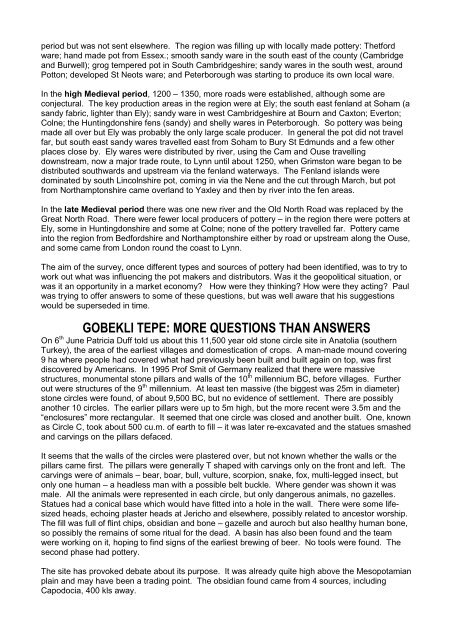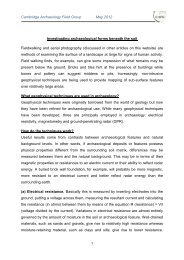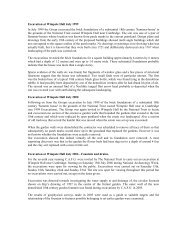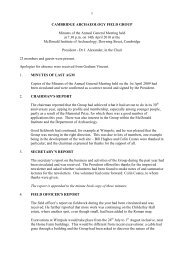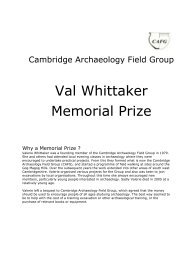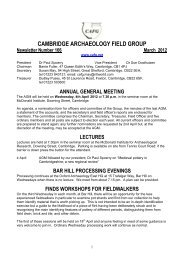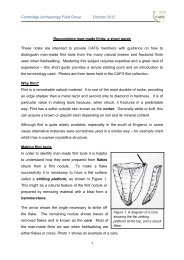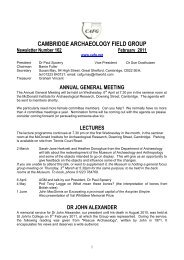CAFG newsletter 168 - Cambridge Archaeology Field Group
CAFG newsletter 168 - Cambridge Archaeology Field Group
CAFG newsletter 168 - Cambridge Archaeology Field Group
You also want an ePaper? Increase the reach of your titles
YUMPU automatically turns print PDFs into web optimized ePapers that Google loves.
period but was not sent elsewhere. The region was filling up with locally made pottery: Thetford<br />
ware; hand made pot from Essex.; smooth sandy ware in the south east of the county (<strong>Cambridge</strong><br />
and Burwell); grog tempered pot in South <strong>Cambridge</strong>shire; sandy wares in the south west, around<br />
Potton; developed St Neots ware; and Peterborough was starting to produce its own local ware.<br />
In the high Medieval period, 1200 – 1350, more roads were established, although some are<br />
conjectural. The key production areas in the region were at Ely; the south east fenland at Soham (a<br />
sandy fabric, lighter than Ely); sandy ware in west <strong>Cambridge</strong>shire at Bourn and Caxton; Everton;<br />
Colne; the Huntingdonshire fens (sandy) and shelly wares in Peterborough. So pottery was being<br />
made all over but Ely was probably the only large scale producer. In general the pot did not travel<br />
far, but south east sandy wares travelled east from Soham to Bury St Edmunds and a few other<br />
places close by. Ely wares were distributed by river, using the Cam and Ouse travelling<br />
downstream, now a major trade route, to Lynn until about 1250, when Grimston ware began to be<br />
distributed southwards and upstream via the fenland waterways. The Fenland islands were<br />
dominated by south Lincolnshire pot, coming in via the Nene and the cut through March, but pot<br />
from Northamptonshire came overland to Yaxley and then by river into the fen areas.<br />
In the late Medieval period there was one new river and the Old North Road was replaced by the<br />
Great North Road. There were fewer local producers of pottery – in the region there were potters at<br />
Ely, some in Huntingdonshire and some at Colne; none of the pottery travelled far. Pottery came<br />
into the region from Bedfordshire and Northamptonshire either by road or upstream along the Ouse,<br />
and some came from London round the coast to Lynn.<br />
The aim of the survey, once different types and sources of pottery had been identified, was to try to<br />
work out what was influencing the pot makers and distributors. Was it the geopolitical situation, or<br />
was it an opportunity in a market economy How were they thinking How were they acting Paul<br />
was trying to offer answers to some of these questions, but was well aware that his suggestions<br />
would be superseded in time.<br />
GOBEKLI TEPE: MORE QUESTIONS THAN ANSWERS<br />
On 6 th June Patricia Duff told us about this 11,500 year old stone circle site in Anatolia (southern<br />
Turkey), the area of the earliest villages and domestication of crops. A man-made mound covering<br />
9 ha where people had covered what had previously been built and built again on top, was first<br />
discovered by Americans. In 1995 Prof Smit of Germany realized that there were massive<br />
structures, monumental stone pillars and walls of the 10 th millennium BC, before villages. Further<br />
out were structures of the 9 th millennium. At least ten massive (the biggest was 25m in diameter)<br />
stone circles were found, of about 9,500 BC, but no evidence of settlement. There are possibly<br />
another 10 circles. The earlier pillars were up to 5m high, but the more recent were 3.5m and the<br />
“enclosures” more rectangular. It seemed that one circle was closed and another built. One, known<br />
as Circle C, took about 500 cu.m. of earth to fill – it was later re-excavated and the statues smashed<br />
and carvings on the pillars defaced.<br />
It seems that the walls of the circles were plastered over, but not known whether the walls or the<br />
pillars came first. The pillars were generally T shaped with carvings only on the front and left. The<br />
carvings were of animals – bear, boar, bull, vulture, scorpion, snake, fox, multi-legged insect, but<br />
only one human – a headless man with a possible belt buckle. Where gender was shown it was<br />
male. All the animals were represented in each circle, but only dangerous animals, no gazelles.<br />
Statues had a conical base which would have fitted into a hole in the wall. There were some lifesized<br />
heads, echoing plaster heads at Jericho and elsewhere, possibly related to ancestor worship.<br />
The fill was full of flint chips, obsidian and bone – gazelle and auroch but also healthy human bone,<br />
so possibly the remains of some ritual for the dead. A basin has also been found and the team<br />
were working on it, hoping to find signs of the earliest brewing of beer. No tools were found. The<br />
second phase had pottery.<br />
The site has provoked debate about its purpose. It was already quite high above the Mesopotamian<br />
plain and may have been a trading point. The obsidian found came from 4 sources, including<br />
Capodocia, 400 kls away.


